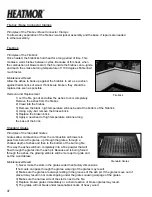
34
Freeze Protection
Principles of Freeze Protection
When the total system is operating as designed, there is no need to add
anti-freeze. However if the water in the outdoor furnace is not going to be kept above 50 degrees Fahrenheit in
cold weather, freeze protection must be considered. In a properly designed system, the indoor appliances will
automatically come on, generate heat, and keep the supply line, return line, and outdoor furnace from freezing
by transferring some of the heat generated, back to the outdoor furnace. This will only happen if the circulating
pumps are running.
it is recommended to always have a backup system in place.
• Freeze protection products have lower heat transfer capabilities than water.
• Freeze protection products will not necessarily inhibit corrosion.
• Some insurance companies will not insure an outdoor furnace with glycol in the system.
• Ensure the correct freeze protection product is used.
non-toxic,
propylene glycol based,
boiler antifreeze is recommended. One such product is DOWFROST HD™ from Dow Chemicals.
Before draining the water, please refer to “removal/replacement of system Water”.
When installing a completely new system, we recommend that the system first be filled with water only. After
two or three days of operation, check that all air is out of the system, and all connections are leak free. Once
the entire system is confirmed to be leak free, add the water treatment. Before adding the treatment, drain out a
corresponding amount of water.
















































